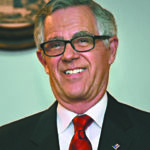

LEGISLATIVE REPORT:
Pension Law and Policy,
By Michael Karsch
By Michael Karsch, Legislative Representative
A Website called Seeking Alpha proclaimed that the Federal Reserve could be blamed for the “coming pension crisis.” Why? It’s because of the way in which the Fed can set interest rates, which have considerable impact on the financial markets.
The lending rate has been too low for too long. Remember the good old days in the 1990s when there were reasonable interest rates that made borrowing a little expensive? Before 2007, interest rates were substantial enough to earn some good money on them. But then the Great Recession began and interest rates went lower and lower. Suddenly those parts of the economy dependent on healthy interest rates were starved. One large segment of the economy that suffered this development were savers at banks and pension funds seeking what pensions have always relied on, reliable and steady income streams. According to Wilshire Consulting, per Seeking Alpha, 97 percent of state pension funds are underfunded. No state is 100 percent funded, but Wisconsin was 99.1 percent funded. The worst states were Kentucky and New Jersey, each at 31 percent. The higher interest rates that used to prevail are now gone; there are fewer young workers in jobs with pensions who are contributing lower-than-needed amounts to fund the increasingly large pension class (the retiring of the Baby Boomers).
Market Watch says, “Low interest rates are compounding the big problems facing pension funds.” In 2001, most public pensions expected returns more than 8 percent (and got them), but today the best returns on their funds is 7.25 percent, or more likely much lower. Fox Business says public pension returns are the lowest in three years, and that all pension plan median returns for the year ending June 28, 2019 were 6.47 percent. Axios.com claims that private “companies are racing to dump their pension plans.” In Idaho, the Idaho Press had a story that property taxes are being raised to fund rising pension costs. The rates paid by government employees to their pension systems are just about at 20 percent. An increase in the homeowner exemption, while being of help to the homeowners, will have an increased burden on other state taxes to provide for the same services.
The City Journal in New York argues that state pension funds keep increasing risky investments as pension debt mounts. That Journal cites a new study by Fitch Ratings that most government pension funds since 2001 had annualized returns of 6.4 percent, well below their stated goals of 7.5 percent to 8 percent returns. Only one pension has met its goal since 2001 (the state plan was not identified).
It’s nice to have low interest rates for purposes of a re-fi house loan or other consumer project. But that hurts pension funds, although every one of them has sought the best of other investment tools. Remember other viewpoints that I have written before about spreading estimated funding set-asides to meet a pension fund’s needs over 10 years, 15 years, and 20 years? This can help to structure sufficient funding and risk. A government entity will always be around, unlike in the private sector. And crucial changes will continue to be made to public pensions, namely asking more from the employee in his/her contribution; in some cases there can be changes in a plan’s benefits; and there is always potentially a change to new hires’ promised pensions who may not be able to share the same pension benefits as current retirees.












